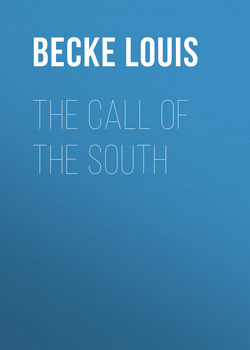The Call Of The South

Реклама. ООО «ЛитРес», ИНН: 7719571260.
Оглавление
Becke Louis. The Call Of The South
CHAPTER I ~ PAUL, THE DIVER
CHAPTER II ~ THE OLD SEA LIFE
CHAPTER III ~ THE BLIND MAN OF ADMIRALTY ISLAND
CHAPTER IV ~ NISÂN ISLAND; A TALE OF THE OLD TRADING DAYS
FIRST PART
SECOND PART
THIRD PART
CHAPTER V ~ MUTINIES
CHAPTER VI ~ “MÂNI”
CHAPTER VII ~ AT NIGHT
CHAPTER VIII ~ THE CRANKS OF THE JULIA BRIG
CHAPTER IX ~ “DANDY,” THE SHIP’S DINGO
CHAPTER X ~ KALA-HOI, THE NET-MAKER
CHAPTER XI ~ THE KANAKA LABOUR TRADE IN THE PACIFIC
CHAPTER XII ~ MY FRIENDS, THE ANTHROPOPHAGI
CHAPTER XIII ~ ON THE “JOYS” OF RECRUITING “BLACKBIRDS”
CHAPTER XIV ~ MAKING A FORTUNE IN THE SOUTH SEAS
CHAPTER XV ~ THE STORY OF TOKOLMÉ
CHAPTER XVI ~ “LANO-TÔ”
CHAPTER XVII ~ “OMBRE CHEVALIER”
CHAPTER XVIII ~ A RECLUSE OF THE BUSH
CHAPTER XIX ~ TE-BARI, THE OUTLAW
CHAPTER XX ~ “THE DANDIEST BOY THAT EVER STOOD UP IN A BOAT”
CHAPTER XXI ~ THE PIT OF MAOTÂ
CHAPTER XXII ~ VANÂKI, THE STRONG SWIMMER
CHAPTER XXIII ~ TWO PACIFIC ISLANDS BIRDS: THE SOUTH SEA CORNCRAKE AND THE TOOTH-BILLED PIGEON THE SOUTH SEA CORNCRAKE
CHAPTER XXIV ~ A NIGHT RUN ACROSS FÂGALOA BAY
CHAPTER XXV ~ A BIT OF GOOD LUCK
CHAPTER XXVI ~ MODERN PIRATES
CHAPTER XXVII ~ PAUTÔE
CHAPTER XXVIII ~ THE MAN WHO KNEW EVERYTHING
CHAPTER XXIX ~ THE PATTERING OF THE MULLET
Отрывок из книги
One Sunday morning—when I was about to leave the dear old city of Sydney for an unpremeditated and long, long absence in cold northern climes, I went for a farewell stroll around the Circular Quay, and, standing on some high ground on the east side, looked down on the mass of shipping below, flying the flags of all nations, and ranging from a few hundred to ten thousand tons. Mail steamers, deep sea tramps, “freezers,” colliers—all crowded together, and among them but one single sailing vessel—a Liverpool barque of 1,000 tons, loading wool. She looked lost, abandoned, out of place, and my heart went out to her as my eyes travelled from her shapely lines and graceful sheer, to her lofty spars, tapering yards, and curving jibboom, the end of the latter almost touching the stern rail of an ugly bloated-looking German tramp steamer of 8,000 tons. On that very spot where I stood I, when a boy, had played at the foot of lofty trees—now covered by hideous ill-smelling wool stores—and had seen lying at the Circular Quay fifty or sixty noble full-rigged ships and barques, many brigs and schooners, and but one steamer, a handsome brig-rigged craft, the Avoca, the monthly P. and O. boat, which ran from Sydney to Melbourne to connect with a larger ship.
Round the point were certainly a few other steamers, old-fashioned heavily-rigged men-of-war, generally paddle-wheel craft; and, out of sight, in Darling Harbour, a mile away, were others—coasters—none of them reaching five hundred tons, and all either barque- or brig-rigged, as was then the fashion.
.....
Against this experience I have had many pleasant ones. In one dear old brig, in which I sailed as supercargo for two years, we carried a double crew—white men and natives of Rotumah Island, and a happier ship never spread her canvas to the winds of the Pacific. This was purely because the officers were good men, the hands—white and native—good seamen, cheerful and obedient—not the lazy, dirty, paint-scrubbers one too often meets with nowadays, especially on cheaply run big four-masted sailing ships, flying the red ensign of Old England.
“Oh, sir,” she cried in trembling tones, “you frightened me.”
.....